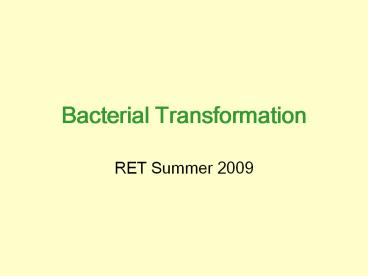Bacterial Transformation PowerPoint PPT Presentation
Title: Bacterial Transformation
1
Bacterial Transformation
- RET Summer 2009
2
Overall Picture
- Bio-Rad pGLO Transformation
- Need
- Good host
- Self-replicating vector to carry our gene
- Selection marker
- Insertion of GFP gene into HB101 E. coli
3
Transformation
- The process of transferring foreign DNA fragments
into a recipient (host) cell for growth and
replication - Our host cells HB101 E. coli
- Our foreign DNA GFP b-lactamase genes
(contained in the pGLO plasmid)
4
Plasmids
- Plasmids
- small (1-200,000 kb)
- circular
- extrachromosomal
- DNA
- Relaxed plasmids replicate independently of the
hosts cell cycle amplification of gene product - A type of cloning vector used to carry a gene not
found in the bacterial hosts chromosome
5
Overall Transformation Process
- The plasmid vector must be cut with a restriction
endonuclease (aka restriction enzyme) - DNA ligase joins the DNA fragment vector DNA
- Host cell is made competent so can plasmid can
enter - Transformed cells are grown on selection media
6
Overall Transformation Process
- The plasmid vector must be cut with a restriction
endonuclease (aka restriction enzyme) - DNA ligase joins the DNA fragment vector DNA
- Host cell is made competent so can plasmid can
enter - Transformed cells are grown on selection media
7
Restriction Enzymes
- Endonucleases
- protect bacteria from intruding DNA in nature
- cut up (restrict) the viral DNA
- can leave blunt or sticky ends
- cut only at very specific nucleotide sequences
- Restriction site
- recognition sequence for a particular restriction
enzyme - Restriction fragments
- segments of DNA cut by
- restriction enzymes in a reproducible way
8
Restriction Enzymes
- Insertion of a gene
- Cut gene of interest with same restriction
enzymes to make complementary sticky ends - DNA ligase
- joins the sticky ends of DNA fragments
- Ideally, you would cut opposite ends of the gene
with different restriction enzymes.
9
Overall Transformation Process
- The plasmid vector must be cut with a restriction
endonuclease (aka restriction enzyme) - DNA ligase joins the DNA fragment vector DNA
- Host cell is made competent so can plasmid can
enter - Transformed cells are grown on selection media
10
Transformation of Bacteria
- Generally occurs through heat shock addition of
a divalent cation (Ca) - Ca stabilizes negatively charged phosphates
- Heat shock briefly permeabilizes the membrane
- Competent cells are those capable of taking up
the plasmid - Cells most likely to become competent are in log
growth phase
11
Overall Transformation Process
- The plasmid vector must be cut with a restriction
endonuclease (aka restriction enzyme) - DNA ligase joins the DNA fragment vector DNA
- Host cell is made competent so can plasmid can
enter - Transformed cells are grown on selection media
12
Selection
- Selective medium - used to determine which
bacterial cells contain the antibiotic resistant
plasmid insert which do not - Example bacterium containing a plasmid with
resistance to a particular antibiotic
(ampicillin) will grow on medium that contains
that antibiotic - In addition, our plasmid contains a regulatory
element that activates the GFP gene only in the
presence of arabinose
13
Selection Media
- LB plates
- LB amp
- LB amp ara
- Control (-pGLO)
Should contain only cells with the amp-resistant
pGLO plasmid colonies appear white (-pGLO,
pGLO)
Should contain only cells with the amp-resistant
pGLO plasmid colonies floresce green (pGLO)
14
Factors that Affect Yield Quality of Plasmid DNA
- Plasmid copy number
- Host strain used, carbohydrate production
- Culture medium, selection, and culture time
- Want to harvest during log growth phase
15
Transformation Applications
16
GFP Uses
- Can be directed to specific subcellular
compartments - Can combine GFP coding region with the regulatory
region for another gene and observe changes in
gene expression - Can be used to make a fusion protein to study
localization, turnover intracellular
associations of native protein - GFP gene is switched on when cells are grown in
the presence of arabinose
- Use as a reporter molecule to follow changes in
gene expression over time - Nondestructive, nontoxic
- Coding sequence can be cloned into a variety of
vectors - GFP keeps its fluorescence in cells from
different species - Can be tracked in living cells over to time to
study development

